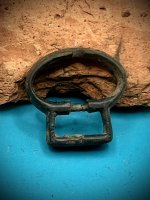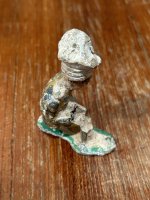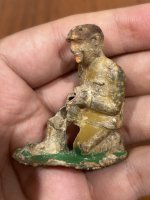Gypsy Heart
Gold Member
In November 1897, the last train robbery of the Santa Fe Railroad occurred near the malpais. While accounts differ, the perpetrators apparently belonged to the Black Jack Christian gang. Gang members boarded the eastbound train either before or at Grant's Station. About six miles east of Grant, the outlaws disengaged the baggage cars from the locomotive and express car. Using explosives, they blew apart the safe discovering $100,000 in gold and currency. The bandits headed south toward the malpais hoping to lose any would-be trackers in the gnarled lava beds. While some of the outlaws were apprehended, the whereabouts of the gold remained elusive giving rise to speculation that it is still hidden in the malpais.
Accounts of buried gold in the malpais persist. The most notorious version of malpais gold is the chronicle of the "Lost Adams Diggings." According to local legends, freighter J.J. Adams had accompanied a party of miners into the malpais in 1864, to search for gold. The group discovered gold but in the process began to run low on provisions. Adams went to Fort Wingate to obtain supplies. On his return, he found all of his companions killed except for one by a band of Apaches. The two men buried the gold and managed to escape the wrath of the Apaches. Adams and his wounded friend, John Brewer, finally reached the sanctuary of Fort Apache, Arizona. While at Fort Apache, Adams allegedly shot an Indian in a dispute over a horse. Imprisoned, he was unable to return to the malpais to reclaim the gold. When Adams reappeared in the malpais some 20 years later, he failed to locate the site. Years of wandering over the rugged lava terrain yielded nothing and Adams left in frustration but not without implanting the seeds of gold legends in the malpais.
At the closing of the final quarter-century of the 1800s, the malpais region reflected remarkable economic and sociological adjustments. The Navajos no longer held dominion over the country, in their stead advanced sheepmen and cattle ranchers. Along the ridges and valleys of the Zuni Mountains, timbermen emerged and tapped into what seemed to them an unlimited resource.
Moreover, dugouts and rough-poled cabins punctuated the landscape. Bean fields and chicken coops, dams and dikes had supplanted a sagebrush environment. Towns like San Rafael, Grant's Station, Thoreau, and Bluewater were survivors in the never-ending cycle of boom or bust. But without the advancement of the railroad none of the changes could have taken place easily. The end of the first quarter-century of the twentieth century still found the area tethered to the railroad's umbilical cord for economic dependence.
Attached:
Figure 5. In the lava beds of New Mexico, the rough, jumbled lava made a haven for outlaws and
spawned luried accounts of gold buried in the malpais.
Photo by W. Cal Brown, Courtesy Museum of New Mexico, Neg. No. 66552
Accounts of buried gold in the malpais persist. The most notorious version of malpais gold is the chronicle of the "Lost Adams Diggings." According to local legends, freighter J.J. Adams had accompanied a party of miners into the malpais in 1864, to search for gold. The group discovered gold but in the process began to run low on provisions. Adams went to Fort Wingate to obtain supplies. On his return, he found all of his companions killed except for one by a band of Apaches. The two men buried the gold and managed to escape the wrath of the Apaches. Adams and his wounded friend, John Brewer, finally reached the sanctuary of Fort Apache, Arizona. While at Fort Apache, Adams allegedly shot an Indian in a dispute over a horse. Imprisoned, he was unable to return to the malpais to reclaim the gold. When Adams reappeared in the malpais some 20 years later, he failed to locate the site. Years of wandering over the rugged lava terrain yielded nothing and Adams left in frustration but not without implanting the seeds of gold legends in the malpais.
At the closing of the final quarter-century of the 1800s, the malpais region reflected remarkable economic and sociological adjustments. The Navajos no longer held dominion over the country, in their stead advanced sheepmen and cattle ranchers. Along the ridges and valleys of the Zuni Mountains, timbermen emerged and tapped into what seemed to them an unlimited resource.
Moreover, dugouts and rough-poled cabins punctuated the landscape. Bean fields and chicken coops, dams and dikes had supplanted a sagebrush environment. Towns like San Rafael, Grant's Station, Thoreau, and Bluewater were survivors in the never-ending cycle of boom or bust. But without the advancement of the railroad none of the changes could have taken place easily. The end of the first quarter-century of the twentieth century still found the area tethered to the railroad's umbilical cord for economic dependence.
Attached:
Figure 5. In the lava beds of New Mexico, the rough, jumbled lava made a haven for outlaws and
spawned luried accounts of gold buried in the malpais.
Photo by W. Cal Brown, Courtesy Museum of New Mexico, Neg. No. 66552






